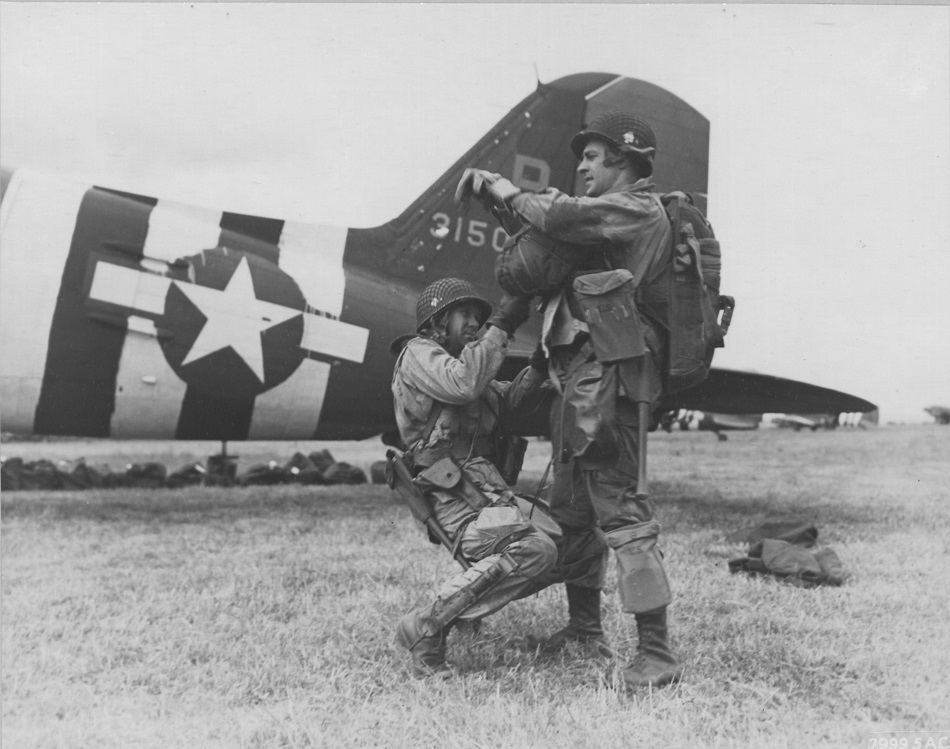
Paratroopers inspect equipment just before takeoff. National Archives
How to register:
We offer two field trip scheduling options:
- Select a field trip from the Museum’s public event schedule
- Request to schedule a field-trip at a time that meets your group’s schedule
Audience:
All audiences. Content appropriate for Grades 6-12.
Goal: Explore how the U.S. Army developed new technology, training, and strategies to overcome challenges and accomplish the mission.
Program Description:
Just after midnight on June 6, 1944, American paratroopers were dropped behind enemy lines to prepare for an invasion force that would arrive at dawn. The Soldiers’ mission was to capture roadways and establish river crossings to support the D-Day invasion. The use of airborne troops, a vital of part the Allies’ campaign plans, was born out of wartime necessity.
Army airborne units were developed to support the concept of vertical envelopment, or the ability to strike an enemy from behind when ground forces could not go around prepared defenses. Born out of response to German success in Holland and Greece, the U.S. Army grew its airborne units from a small test platoon in 1940, through battalion and regimental combat in North Africa and Italy, to multiple combat ready divisions by D-Day. Following the invasion, airborne troops would be deployed during Operation Market Garden and the Battle of the Bulge and earned a reputation for changing the battlefield as soon as they entered it.
In this virtual field trip, explore how the U.S. Army developed new technology, training, and strategies to overcome challenges and accomplish the mission. Learn how Army airborne troops contributed to Allied turning points during World War II.
Objective: At the end of this lesson students, will be able to
- Understand how the U.S. Army adapts and innovates to solves problems.
- Describes the U.S. Army’s role in major turning points in the European Theater.
Guiding Questions:
How does the U.S. Army solve problems?
How did U.S. Army paratroopers contribute to the turning points of World War II?
Curriculum Connections
Common Core Standards
- CCSS.ELA-LITERACY.RH.6-8.2
Determine the central ideas or information of a primary or secondary source; provide an accurate summary of the source distinct from prior knowledge or opinions.
History and Social Science Standards of Learning for Virginia Public Schools
- United States History 1865 to Present
- USII.6 The student will apply history and social science skills to understand the major causes and events of World War II and the effects of America’s role by
- C) locating and describing the major events and turning points of the war in Europe, including, but not limited to the allied invasion of Italy, the invasion of Normandy (D-Day), the Battle of the Bulge, and the Battle of Berlin.
- USII.6 The student will apply history and social science skills to understand the major causes and events of World War II and the effects of America’s role by
- Virginia and United States History
- VUS.14 The student will apply history and social science skills to analyze the United States’ involvement in World War II by
- C) identifying the similarities and differences in the strategy, major battles, and impacts of key leaders of the Axis and Allied Powers.
- E) describing major battles of World War II, including Midway, Normandy, Iwo Jima, Okinawa, and the Battle of the Bulge, as well as battles in Holland, Italy, and North Africa.
- VUS.14 The student will apply history and social science skills to analyze the United States’ involvement in World War II by
Your message has been submitted.
